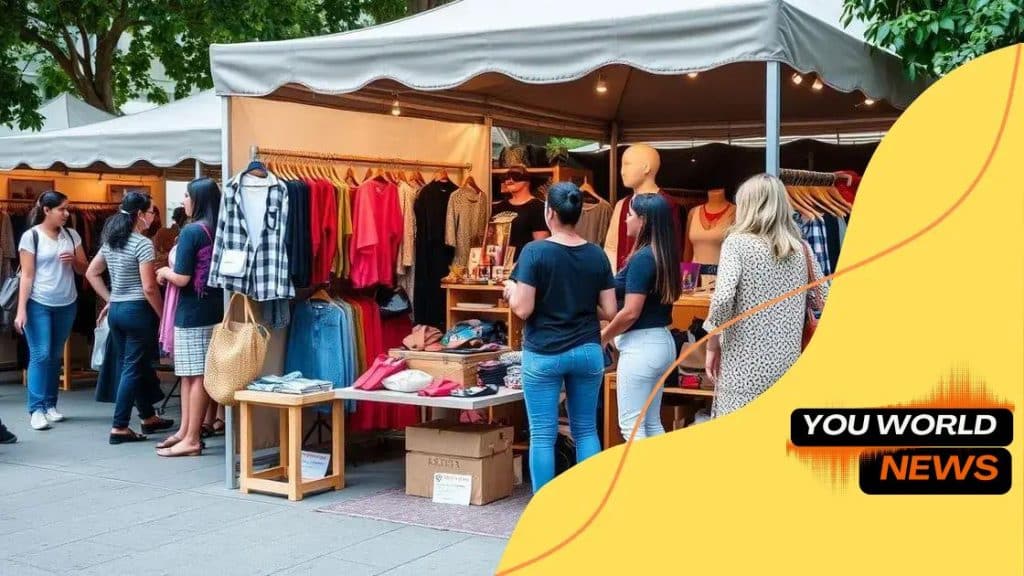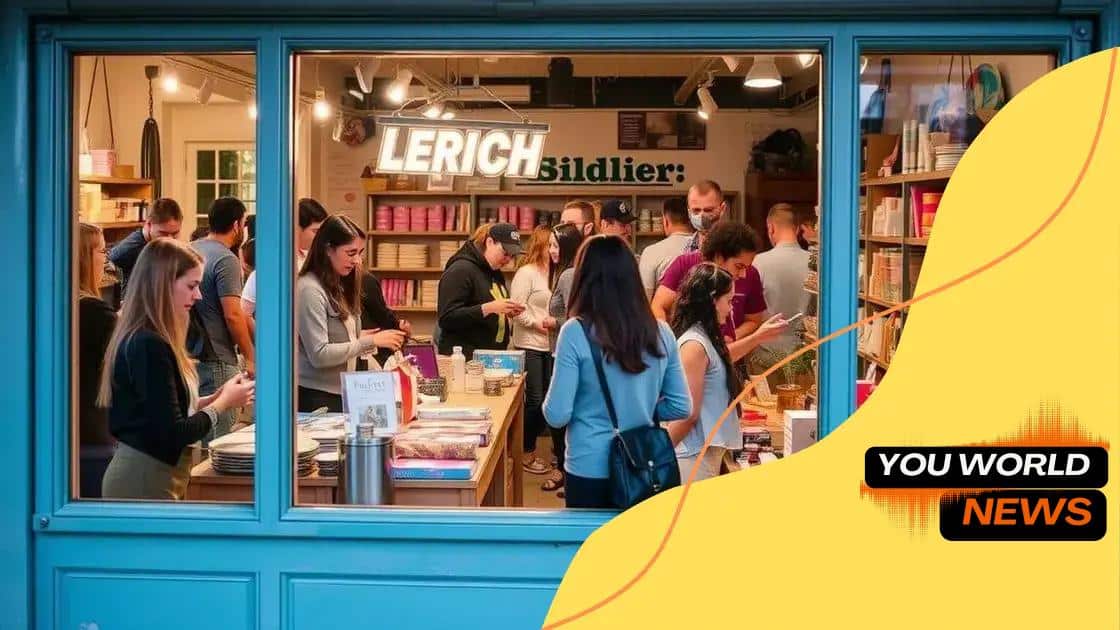How pop-up shops are reshaping fashion retail events

Pop-up shops are temporary retail spaces that enhance brand visibility and customer engagement through unique experiences, innovative marketing, and the opportunity to test new products in direct connection with consumers.
How pop-up shops are reshaping fashion retail events is a fascinating topic, as these temporary setups create buzz and excitement around brands. Have you noticed how they transform the shopping experience? Let’s delve into their impact.
Understanding the concept of pop-up shops
Understanding the concept of pop-up shops is essential to grasping their significance in the retail industry. These temporary storefronts can appear almost anywhere, capturing the attention of passersby and offering unique shopping experiences.
Pop-up shops typically operate for a limited time, creating a sense of urgency for customers. This concept not only showcases products but also helps brands connect with consumers in innovative ways.
Why Are Pop-Up Shops Important?
They enable brands to create buzz and excitement around their products without the long-term commitment of a traditional store. Moreover, they allow brands to test new markets and gather valuable customer feedback.
- Enhancing brand visibility
- Building customer relationships
- Offering exclusive products
- Creating memorable experiences
The flexibility of pop-up shops means they can target specific events or locations, reaching customers where they are. For example, setting up a shop during a local festival can lead to increased foot traffic and brand exposure.
Additionally, these shops often implement interactive elements, such as workshops or live demos, to engage customers. This interactive approach not only attracts more visitors but also fosters a sense of community around the brand.
Challenges of Pop-Up Shops
While pop-up shops provide many benefits, they also come with challenges. Brands must carefully plan logistics, including location, staffing, and inventory management. Success relies on effective promotion and ensuring a seamless customer experience.
In essence, pop-up shops are a dynamic way to attract and engage consumers, reinventing the shopping experience through creativity and innovation.
The benefits of pop-up shops for brands
The benefits of pop-up shops for brands are significant in today’s retail landscape. These temporary shops provide unique opportunities to boost visibility and engage customers directly.
Brands can create an exclusive buzz around their products by operating in pop-up formats. This strategy allows them to present new collections or promote limited-time offers that attract shoppers eager for something special.
Increased Brand Awareness
One of the primary advantages of pop-up shops is their ability to enhance brand awareness. By choosing strategic locations, brands can reach new audiences.
- Interactive experiences draw in crowds.
- Social media buzz leads to greater online visibility.
- Unique storefronts create memorable impressions.
- Participation in events can attract diverse customer bases.
Through these experiences, brands build strong emotional connections with customers, encouraging them to share their experiences online. This sharing generates organic marketing that is both authentic and cost-effective.
Market Testing and Customer Feedback
Another significant perk is the ability to test products and gather feedback. Operating a pop-up shop allows brands to experiment with new items, colors, and styles before making larger investments.
Feedback gathered directly from shoppers can drive future product decisions and marketing strategies. By interacting with customers face-to-face, brands can gain insights into consumer preferences that go beyond data analytics.
This hands-on approach not only informs brands but also helps improve customer satisfaction by aligning offerings with actual consumer desires. It fosters adaptability in an ever-changing market.
How pop-up shops enhance customer experience

How pop-up shops enhance customer experience is a vital aspect of their charm. These temporary retail spaces offer unique interactions that typical stores often miss. Customers are drawn in by the novelty and exclusivity of pop-up shops.
When shopping at a pop-up shop, consumers enjoy a tailored experience that is often immersive and interactive. This environment allows customers to engage with the brand in a way that feels personal and special.
Creating Unique Experiences
Pop-up shops often host events, demonstrations, or workshops that invite consumers to participate actively. This format breaks the traditional shopping mold and fosters a deeper connection between the brand and the customer.
- Providing personalized services enhances customer loyalty.
- Interactive displays encourage engagement with products.
- Themed experiences create memorable shopping adventures.
- Limited-time offerings generate excitement and urgency.
By integrating fun and engaging elements, brands captivate shoppers, making their visits enjoyable and memorable. Such experiences can turn casual shoppers into dedicated fans.
Building Community and Connection
Pop-up shops also help build a sense of community. They often emerge in local areas, allowing brands to connect with customers beyond the sale. Engaging with local culture and values makes the shopping experience feel inclusive and relevant.
Customers appreciate the chance to interact with brand representatives who can share stories and answer questions. This personal touch not only improves customer satisfaction but also encourages word-of-mouth marketing.
Overall, the dynamic atmosphere of pop-up shops transforms ordinary shopping into a memorable adventure. Consumers leave with not only products but also stories and experiences to share.
Challenges faced by pop-up shops
Challenges faced by pop-up shops can affect their overall success. While these temporary retail spaces offer unique advantages, they also come with obstacles that brands must navigate to thrive.
One significant challenge is securing a suitable location. Finding a space that attracts the right audience can be tough. The location needs to be accessible and in a high-traffic area to ensure sufficient footfall.
Logistics and Operational Issues
Logistical issues also play a crucial role in the execution of pop-up shops. Brands need to manage inventory efficiently and ensure that they have enough stock to meet demand without overcommitting resources.
- Managing staffing can be difficult for short-term operations.
- Setting up the shop quickly and efficiently is essential.
- Coordinating with landlords and local regulations can complicate planning.
- Technology integration, like payment systems, must be seamless.
Another hurdle is the marketing efforts needed to draw in customers. Without proper promotion, even the best locations can go unnoticed. Brands often rely on social media, local influencers, and community events to create buzz.
Consumer Behavior and Competition
Consumer expectations can also pose a challenge. Shoppers today expect personalized experiences and unique offerings. If a pop-up shop fails to deliver, it can lead to negative impressions of the brand.
Competition from other brands or traditional retail environments can overshadow a pop-up’s presence. Brands must find ways to stand out, whether through exclusive products, engaging events, or exceptional customer service.
Ultimately, addressing these challenges is essential for the success of pop-up shops. By carefully planning and executing strategies, brands can navigate these obstacles and create rewarding customer experiences.
Future trends in pop-up retail
Future trends in pop-up retail are shaping how brands interact with consumers. As the retail landscape evolves, pop-up shops are adapting to meet new demands and expectations.
One growing trend is the integration of technology. Brands are increasingly incorporating virtual and augmented reality experiences into their pop-up shops. This immersive technology allows customers to interact with products in innovative ways, making the shopping experience more engaging.
Sustainability and Ethical Practices
Another trend is a stronger focus on sustainability. Consumers are becoming more aware of environmental issues and are seeking brands that prioritize eco-friendly practices. Pop-up shops can showcase sustainable products and educate customers about environmentally friendly choices.
- Using recycled materials for displays and packaging.
- Offering upcycled or fair-trade products.
- Implementing measures to reduce waste.
- Promoting local artisans and small businesses.
Moreover, future pop-up shops are likely to explore collaborations with local artists and creators. These partnerships can lead to unique, limited-edition products that enhance the shopping experience and foster community connections.
Experiential Retail and Personalization
Experiential retail will continue to grow, as consumers seek memorable shopping experiences. Pop-up shops can host events, workshops, and interactive demos that allow customers to engage directly with the brand and products.
Personalization is also essential. Brands can utilize data and customer preferences to tailor experiences, ensuring shoppers feel valued. This might involve customized products or personalized shopping recommendations.
As pop-up retail evolves, the focus will be on innovation, sustainability, and creating meaningful connections with consumers. By keeping up with these trends, brands can thrive in the ever-changing retail environment.
FAQ – Frequently Asked Questions about Pop-Up Shops
What are pop-up shops?
Pop-up shops are temporary retail spaces established by brands to engage with customers and showcase products in a unique setting.
How do pop-up shops enhance customer experiences?
They create memorable interactions through exclusive products, immersive events, and personalized services that draw customers in.
What are the main challenges faced by pop-up shops?
Common challenges include finding the right location, managing logistics, ensuring adequate staffing, and effectively marketing the shop.
What future trends can we expect in pop-up retail?
Future trends may include increased technology integration, a focus on sustainability, and enhanced personalization to create unique shopping experiences.





